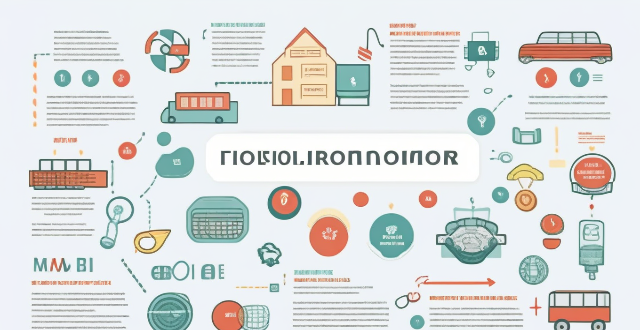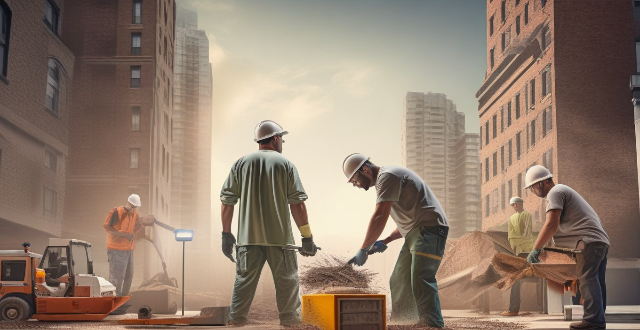Emergency Area

How can I prepare for an emergency situation ?
The article provides a comprehensive guide on how to prepare for an emergency situation. It emphasizes the importance of being prepared for emergencies, which can strike at any time and pose a threat to the safety of individuals and their loved ones. The first step in preparing for an emergency is to assess the risks that are most likely to affect you. This involves identifying potential natural disasters or man-made emergencies that could occur in your area. Once you have identified these risks, you can begin to develop a plan for how to respond. The next step is to create an emergency kit that contains all the essential items you will need in case of an emergency. This includes water, non-perishable food, a first aid kit, a flashlight, warm clothing, a map of the area, a cell phone with charger, cash, and important documents. Having a plan in place is also crucial in ensuring that everyone knows what to do in case of an emergency. Your plan should include a designated meeting place, an evacuation route, a communication strategy, and a backup plan. Staying informed about local weather reports and news alerts is another important aspect of emergency preparedness. Signing up for community warning systems can also help you stay informed about potential emergencies in your area. Finally, practicing your emergency plan regularly can help ensure that everyone remains calm and focused during an actual emergency situation. This could involve conducting regular fire drills or practicing evacuation routes.

How can I stay informed about potential disasters in my area ?
In the text, the author discusses the importance of staying informed about potential disasters in one's area and provides steps to achieve this. The key takeaways are that knowledge is power, timely information can make a significant difference in safety and damage control, and being informed helps contribute positively to community preparedness efforts. The steps to stay informed include identifying local alert systems such as local government websites and apps, the National Weather Service, and emergency management agencies. Subscribing to alert services like Wireless Emergency Alerts, NOAA Weather Radio, and email newsletters and text messages from local authorities is also recommended. Social media and news sources can provide real-time updates, but it is important to ensure that the information comes from a verified source to avoid misinformation. Community networks such as neighborhood watch groups, town hall meetings, and volunteering for local emergency response teams can also provide valuable information. Regular updates and drills, such as reviewing and updating personal and family emergency plans, participating in local evacuation drills or safety exercises, and taking advantage of educational resources like FEMA's "Are You Ready?" campaign, can help individuals stay informed and prepared for potential disasters. Overall, the text emphasizes the importance of staying informed about potential disasters in one's area and provides practical steps to achieve this goal.

What should be included in a basic emergency kit ?
A basic emergency kit should include essential items such as water, non-perishable food, a first aid kit, warm clothing and bedding, lighting and communication tools, a multipurpose tool, cash, personal documents, and a map. The contents may vary depending on the type of emergency and household size. It is important to regularly review and update the kit to ensure it remains effective.

How can I ensure the safety of my family during an emergency ?
To ensure the safety of your family during an emergency, create an emergency plan that includes a contact list, meeting place, escape routes, and assigned responsibilities. Maintain essential supplies such as food, water, medical supplies, and an emergency kit. Stay informed about local emergencies through news sources, alert apps, and local alert systems. Secure your home by inspecting for hazards, reinforcing doors and windows, and having smoke detectors and fire extinguishers. Educate your family on self-defense techniques, first aid and CPR, and discuss potential emergencies.

What are the key steps to take during an emergency evacuation ?
During an emergency evacuation, it is important to stay calm and alert, follow evacuation procedures, gather essential items, check for hazards, help others, listen to instructions from authorities, move quickly but safely, and assemble at designated areas. Staying calm helps in thinking clearly and making quick decisions, while being alert means paying attention to surroundings and instructions. Familiarizing with building's evacuation procedures beforehand, looking for exit signs, avoiding elevators, and using stairs are crucial. Gathering important documents, medications, and other essential items on the way out is also important. Checking for potential hazards such as fire, smoke, or structural damage, and seeking assistance from emergency personnel if a path is blocked is necessary. Helping others who may need assistance, remaining together as a group, and staying in contact throughout the evacuation process is recommended. Listening carefully to instructions given by authorities or emergency personnel is crucial as they may provide additional information about the situation or direct to specific locations for safety or further assistance. Moving quickly but avoiding running or pushing others, watching your step to avoid tripping or falling, especially if there are obstacles or debris on the ground is important. Proceeding to the designated assembly area where authorities can take attendance and provide further instructions, and not returning to the building until instructed to do so by authorities is also recommended.

Can you explain the hierarchy of safety signage (i.e., prohibition, warning, mandatory, and emergency) ?
The hierarchy of safety signage is divided into four categories: prohibition, warning, mandatory, and emergency. Prohibition signs indicate actions that are not allowed, while warning signs alert individuals to potential hazards. Mandatory signs indicate required actions for safety, and emergency signs provide critical information during emergencies. Understanding this hierarchy is crucial for creating a safe work environment.

What is the best way to store an emergency kit in a small apartment ?
When it comes to emergency preparedness, having an emergency kit is essential. However, if you live in a small apartment, finding the space to store all the necessary items can be challenging. Here are some tips on how to store an emergency kit in a small apartment: Determine the type of emergency kit you need, choose the right container, organize your kit, and store it properly. Keep your emergency kit in an easily accessible location, avoid storing it under heavy objects or in areas that may be blocked by debris during an emergency, check it regularly to ensure that items are still usable and up-to-date, replace any expired items promptly, and consider storing additional copies of important documents in your emergency kit. By following these tips, you can effectively store an emergency kit in a small apartment while still being prepared for any potential emergencies.

What should female travelers do in case of emergency abroad ?
Female travelers should prepare for emergencies abroad by researching their destination, having a travel plan, registering with their embassy, preparing an emergency kit, and learning basic language skills. In case of an emergency, they should assess the situation, seek help, take protective measures, and communicate with loved ones. After dealing with the immediate emergency, they should seek medical attention, report the incident, and reflect on their response. Additional tips include trusting their instincts, considering travel insurance, and staying connected.

How important is communication during an emergency response ?
Communication is a critical component of any emergency response. It helps to coordinate efforts, gather information, make decisions, and ensure the safety of all parties involved. Effective communication can streamline the response process and avoid confusion or misunderstandings. The importance of communication during an emergency response includes coordination, information gathering, decision making, and safety. Best practices for communication during an emergency response include using clear and concise language, establishing a chain of command, using multiple channels of communication, and maintaining situational awareness. By following these best practices, you can help to streamline the response process and minimize damage. Remember that effective communication is essential for ensuring the safety and well-being of everyone involved in emergencies.

What is the impact of communication interference on emergency services ?
Communication interference can significantly impact emergency services by delaying response time, impairing coordination, increasing risk to responders and victims, disrupting technology, and negatively affecting public perception. It is crucial for emergency services to prioritize reliable communication systems and protocols to minimize the impact of interference and ensure effective responses to emergencies.

What role does technology play in emergency response ?
The article discusses the various ways technology is used in emergency response, including communication via instant messaging platforms and two-way radios, GPS tracking for vehicles and personnel, data analysis for crime and fire trends, and the use of drones and robots. Technology has made emergency response more efficient and effective by improving communication, location tracking, data analysis, and automation.

How do I train my employees for emergency situations ?
Training employees for emergency situations is crucial to ensure their safety and minimize the impact of emergencies on your business. Here's a summary of the key steps involved: 1. Identify potential emergencies that could occur in your workplace, such as fire, medical emergencies, natural disasters, workplace violence, and chemical spills or hazardous materials incidents. 2. Develop an emergency plan that outlines the steps employees should take during each type of emergency. This plan should include evacuation procedures, first aid protocols, contact information for emergency services, safe locations, and procedures for accounting for all employees after an emergency. 3. Conduct regular emergency drills to ensure that employees are familiar with the emergency plan and know what to do in case of an emergency. Drills should be conducted at least annually and cover all types of emergencies identified in the emergency plan. 4. Provide training on how to use safety equipment such as fire extinguishers, first aid kits, and safety goggles. This training should be provided during new employee orientation and refresher courses should be offered regularly. 5. Encourage open communication between employees and management regarding safety concerns and suggestions for improvement. This can be done through regular safety meetings, suggestion boxes, or anonymous surveys. By following these steps, you can create a safe and prepared workforce that is ready to handle any emergency situation.

How important is it to have a portable emergency kit when traveling abroad ?
**The Importance of a Portable Emergency Kit for Traveling Abroad** Embarking on an international journey requires preparation, especially in handling unforeseen events. Here's why carrying a portable emergency kit is crucial: 1. **Preparedness for Unexpected Circumstances**: It helps manage medical emergencies, natural disasters, and travel delays effectively. 2. **Components of an Ideal Emergency Kit**: Includes first aid supplies, hygiene items, nutrition, lighting, important documents, and protective gear. 3. **Customization Based on Destination**: Tailor the kit to climate considerations and location-specific needs for better preparedness. 4. **Peace of Mind**: Being prepared offers peace of mind, allowing focus on enjoying the trip rather than worrying about potential issues.

How can I improve my company's emergency response capabilities ?
Improving your company's emergency response capabilities is crucial for ensuring the safety of employees, customers, and assets. Here are some steps you can take to enhance your organization's ability to handle emergencies effectively: 1. Conduct a Risk Assessment 2. Develop an Emergency Response Plan 3. Train Employees and Conduct Drills 4. Invest in Technology and Equipment 5. Maintain a Culture of Safety

How can I create an emergency evacuation plan for my family ?
Creating an emergency evacuation plan is crucial for the safety of your family during unexpected events such as natural disasters, fires, or other emergencies. Here are some steps to help you create a comprehensive emergency evacuation plan: 1. Identify potential risks that could affect your home and community. 2. Gather important information including contact information, medical information, insurance information, and financial information. 3. Determine the best evacuation routes from your home in case of an emergency. 4. Choose a meeting place outside of your home where your family can regroup in case of an emergency. 5. Practice your emergency evacuation plan with your family on a regular basis. 6. Stay informed about potential risks and updates from local authorities.

Is fiber optic broadband available in my area ?
Fiber optic broadband is becoming increasingly popular due to its high speed and reliability. However, the availability of fiber optic broadband depends on the area you live in. In this article, we will discuss how to check if fiber optic broadband is available in your area. The first step is to check with your current internet service provider (ISP) if they offer fiber optic broadband in your area. You can contact them through their website or customer service hotline. They should be able to provide you with information about the availability of fiber optic broadband in your area. There are several online tools that can help you determine if fiber optic broadband is available in your area. One such tool is the [National Broadband Map](https://www.broadbandmap.gov/), which provides detailed information about broadband availability across the United States. Another tool is the [Google Fiber Checker](https://fiber.google.com/cities/), which allows you to enter your address and see if Google Fiber is available in your area. Local government agencies may also have information about the availability of fiber optic broadband in your area. You can contact your city or county government office and ask if they have any information about fiber optic broadband providers in your area. If you have friends or neighbors who use fiber optic broadband, you can ask them if they know of any providers in your area. They may be able to provide you with valuable information about the availability of fiber optic broadband in your area. In conclusion, checking the availability of fiber optic broadband in your area can be done by contacting your ISP, using online tools, checking with local government agencies, and asking your neighbors. By following these steps, you can determine if fiber optic broadband is available in your area and choose the best provider for your needs.

Are there any special considerations for creating an emergency kit for children ?
Special considerations for creating an emergency kit for children include age-appropriate items, comfort items, snacks and water, clothing and footwear, and entertainment. It is important to tailor the contents of the kit to the child's needs and abilities, and include items that can help to calm and reassure the child during an emergency situation.

What actions are being taken globally to address the climate emergency ?
The climate emergency is a pressing issue caused by human activities leading to global warming. International agreements like the Paris Agreement aim to limit global warming, and many countries have implemented national policies such as carbon pricing and renewable energy mandates. Corporations are also taking actions to reduce emissions and invest in clean energy. Addressing the climate emergency requires a global effort from all levels of society.

What kind of first aid supplies should I have in my home emergency kit ?
This article provides a comprehensive list of essential items to include in a home emergency first aid kit. It covers various categories such as adhesive bandages, gauze and roller bandages, medical tape and safety pins, antiseptics and disinfectants, pain relievers and fever reducers, tools and miscellaneous items, and personal items. The article emphasizes the importance of regularly checking expiration dates and replacing supplies as needed. It also suggests ensuring that all family members are aware of the kit's location and how to use its contents properly.

How can I quickly clear out and organize my desk area ?
Clearing out and organizing your desk area is a task that requires both physical effort and mental clarity. Here are some steps to help you get started: ### Step 1: Remove everything from your desk First, take everything off your desk. This includes papers, pens, books, electronic devices, and any other items that may be cluttering up your workspace. - Papers: File them away or recycle them if they are no longer needed. - Pens and pencils: Place them in a cup or holder. - Books: Store them on a nearby shelf or in a cabinet. - Electronic devices: Unplug them and store them in a safe place. ### Step 2: Clean your desk Once everything is off your desk, it's time to clean it. Use a damp cloth to wipe down the surface of your desk, being sure to get into all the nooks and crannies. If there are any stubborn stains, use a small amount of soap and water to remove them. ### Step 3: Organize your space Now that your desk is clean, it's time to start organizing your space. Here are some tips: - Create zones: Designate specific areas for different tasks. For example, one side of your desk could be for writing and another for computer work. - Use storage containers: Invest in some storage containers or drawer dividers to keep small items organized. - Label everything: Label folders, boxes, and drawers so you know where everything goes. - Keep only what you need: Don't let unnecessary items clutter up your workspace. Only keep what you need within arm's reach. ### Step 4: Maintain your organization Finally, it's important to maintain your newly organized desk area. Make sure to put things back where they belong after each use, and take a few minutes at the end of each day to tidy up your workspace. By doing this, you'll be able to keep your desk area clean and organized for years to come!

What steps should I take to prepare my home for a natural disaster ?
Preparing your home for natural disasters is crucial to ensure the safety of your family and property. Here's a summary of key steps: 1. **Assess Your Risk**: Identify potential disasters and determine your vulnerability based on location. 2. **Develop an Emergency Plan**: Create and practice a plan outlining evacuation routes and meeting places. 3. **Secure Your Home**: Take measures like securing loose objects, reinforcing windows/doors, installing shutters, anchoring furniture, trimming trees, clearing gutters, inspecting the roof, and considering a sump pump. 4. **Maintain Essential Supplies**: Stock up on food, water, medication, first aid kits, backup power sources, important documents in waterproof containers, and prepare an emergency kit. 5. **Stay Informed**: Keep updated on weather conditions and sign up for emergency alerts. By following these steps, you can significantly reduce the risks associated with natural disasters and ensure better preparedness and recovery.

How do I assemble an emergency preparedness kit for my office ?
The text provides a detailed guide on how to assemble an emergency preparedness kit for your office, highlighting the importance of being prepared for potential emergencies. It outlines the steps involved in creating a comprehensive kit, including identifying potential emergencies, choosing a suitable container, and selecting essential items such as water, food, first aid supplies, light sources, battery-powered radios, personal items, tools, important documents, and sanitation supplies. The article emphasizes the need to regularly check and update the kit to ensure its usability and relevance to potential emergencies in the area.

How do I ensure my pets are safe during an emergency situation ?
Ensuring your pets' safety during emergency situations is crucial, and there are several steps you can take to prepare. Firstly, proper identification through microchipping and collar tags is essential. Secondly, having an evacuation plan with a designated caregiver and shelter options is important. Thirdly, preparing an emergency kit with necessary supplies is vital. Fourthly, staying informed about potential emergencies in your area is crucial. Lastly, practicing evacuation drills can help familiarize your pets with the process. By following these steps, you can ensure the safety of your pets during emergency situations.

What role do safety drills play in emergency preparedness ?
Safety drills play a pivotal role in emergency preparedness by raising awareness, practicing response skills, building teamwork, assessing readiness, and ensuring compliance with regulations. They familiarize individuals with procedures, identify hazards, enhance key skills like evacuation and first aid, foster coordinated responses, develop leadership, reveal gaps for improvement, and meet legal standards, ultimately creating a culture of safety.

What are some common types of emergencies and how should they be handled ?
Emergencies can occur at any time and place, often without warning. Knowing the types of emergencies and how to handle them is crucial for ensuring safety and minimizing harm. In this article, we will discuss some common types of emergencies and their appropriate handling methods. ## Natural Disasters Natural disasters are events caused by environmental factors that result in widespread damage and loss of life. Some common types of natural disasters include earthquakes, hurricanes, floods, wildfires, and tornadoes. When faced with a natural disaster, it is essential to stay calm, seek shelter, follow evacuation orders, have an emergency kit ready, and stay informed about the situation. ## Medical Emergencies Medical emergencies refer to situations where immediate medical attention is required to prevent serious harm or death. Some common types of medical emergencies include heart attacks, strokes, severe allergic reactions, severe bleeding, and choking. When dealing with a medical emergency, it is crucial to call for help, perform first aid if trained, use automated external defibrillators (AEDs) if available, do not move the victim unless necessary, and stay with the victim until help arrives. ## Fire Emergencies Fire emergencies involve uncontrolled fires that pose a threat to people and property. Some common types of fire emergencies include house fires, wildfires, car accidents involving fire, and industrial fires. When facing a fire emergency, it is important to activate fire alarms/alert others, evacuate safely through designated exits, call emergency services immediately, do not reenter burning buildings, and use fire extinguishers appropriately if trained and safe to do so. In conclusion, being prepared for emergencies is crucial for ensuring safety and minimizing harm. By understanding common types of emergencies and their appropriate handling methods, individuals can respond effectively in crisis situations. Remember to stay calm, act quickly, and follow proper procedures to protect yourself and others.

How important is an earthquake emergency kit, and what should it contain ?
The text discusses the importance of being prepared for earthquakes by having an emergency kit with essential items such as water, food, a first aid kit, light sources, clothing, bedding or shelter, tools, sanitation and personal needs, important documents, cash, communication tools, maps and information. It also mentions additional considerations like pet care and multi-tools.

How do I provide care for someone experiencing anaphylactic shock ?
Anaphylactic shock is a severe allergic reaction that requires immediate care. To provide care for someone experiencing it, recognize the symptoms like skin reactions and respiratory distress, call for emergency help, use an epinephrine auto-injector if available, position the person comfortably, loosen tight clothing, keep them calm, monitor vital signs, and follow instructions from emergency personnel. Timely action can greatly improve the chances of recovery.

How do I administer CPR correctly in an emergency situation ?
Administering CPR correctly in an emergency situation involves a series of steps to ensure the victim receives proper care until professional help arrives. The key steps include: checking the safety of the scene, calling for help, checking the victim's responsiveness, looking for an AED, opening the airway, checking for breathing, performing chest compressions if the victim is not breathing, giving rescue breaths (if trained), using an AED (if available), and continuing CPR until help arrives or the victim starts breathing normally. The quality of chest compressions is crucial, as they must be hard and fast enough to mimic a heartbeat and force blood out to vital organs.

What are the best practices for篝火 safety to prevent uncontrolled fires ?
Fire safety is crucial when enjoying a bonfire. Here are some best practices to ensure a safe and enjoyable experience: 1. Choose the Right Location: Find a clear area away from trees, bushes, and any other flammable materials. Ensure that the fire pit or ring is made of non-flammable materials. 2. Check Local Regulations: Be aware of any local laws or regulations regarding open fires. Obtain necessary permits if required. 3. Gather Supplies: Have a fire extinguisher or a bucket of sand/water nearby. Prepare shovels and other tools for tending the fire and emergency situations. 4. Stack Wood Properly: Use dry, seasoned wood to reduce smoke and flame-ups. Build a 'log cabin' or 'teepee' structure for better airflow. 5. Light the Fire Safely: Use a match or lighter; avoid using accelerants like gasoline or lighter fluid. Light the fire from the upwind side to prevent sparks from blowing onto you. 6. Keep the Fire Small: Only build a fire as big as needed for warmth and light. Don't add too much fuel at once; keep it manageable. 7. Never Leave the Fire Unattended: Always have someone present to watch the fire. Have a plan in place for emergencies or if you need to leave temporarily. 8. Monitor Wind Conditions: Be aware of changing wind patterns that could spread sparks or embers. If conditions become unsafe, be prepared to extinguish the fire promptly. 9. Properly Extinguish the Fire: Drown the fire with water, ensuring that all embers are wet and cold to the touch. Stir the ashes and add more water until everything is completely soaked. 10. Dispose of Ashes Carefully: After the fire is completely out, allow the ashes to cool before disposal. Place ashes in a metal container and dispose of them in a proper location. 11. Clean Up the Area: Remove any trash or leftover materials from the site. Leave the area cleaner than you found it.

What are the initial steps for managing a fracture until professional help arrives ?
Managing a fracture involves assessing the situation, immobilizing the injured area, controlling bleeding, elevating the injured area, and managing pain and discomfort until professional help arrives. It is important to use sturdy materials for splints and secure them properly to prevent further damage. Applying pressure to control bleeding and elevating the injured area can help reduce swelling and pain. Pain management options include taking over-the-counter pain relievers and applying cold compresses. Emotional support and reassurance are also important during this stressful time.